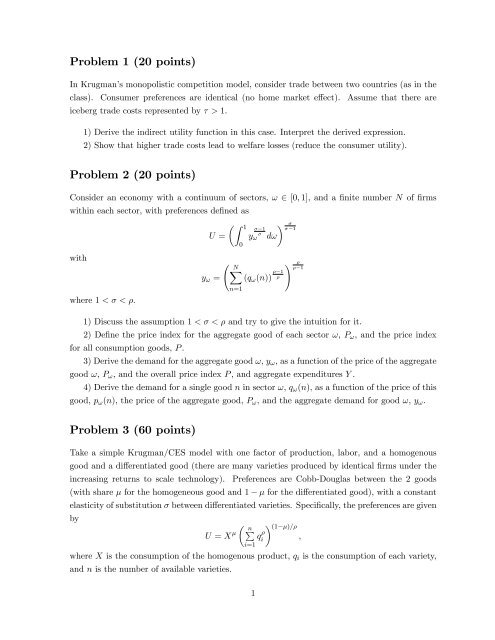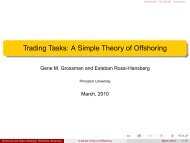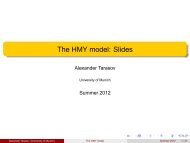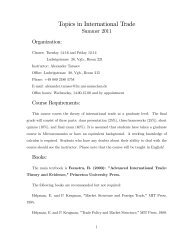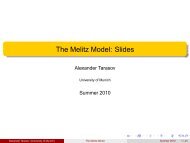Problem Set 2
Problem Set 2
Problem Set 2
You also want an ePaper? Increase the reach of your titles
YUMPU automatically turns print PDFs into web optimized ePapers that Google loves.
<strong>Problem</strong> 1 (20 points)<br />
In Krugman’s monopolistic competition model, consider trade between two countries (as in the<br />
class). Consumer preferences are identical (no home market e¤ect). Assume that there are<br />
iceberg trade costs represented by > 1.<br />
1) Derive the indirect utility function in this case. Interpret the derived expression.<br />
2) Show that higher trade costs lead to welfare losses (reduce the consumer utility).<br />
<strong>Problem</strong> 2 (20 points)<br />
Consider an economy with a continuum of sectors, ! 2 [0; 1], and a …nite number N of …rms<br />
within each sector, with preferences de…ned as<br />
with<br />
where 1 < < .<br />
Z 1<br />
U =<br />
y ! =<br />
0<br />
NX<br />
n=1<br />
<br />
y 1 1<br />
<br />
! d!<br />
! <br />
(q ! (n)) 1 1<br />
<br />
1) Discuss the assumption 1 < < and try to give the intuition for it.<br />
2) De…ne the price index for the aggregate good of each sector !, P ! , and the price index<br />
for all consumption goods, P .<br />
3) Derive the demand for the aggregate good !, y ! , as a function of the price of the aggregate<br />
good !, P ! , and the overall price index P , and aggregate expenditures Y .<br />
4) Derive the demand for a single good n in sector !, q ! (n), as a function of the price of this<br />
good, p ! (n), the price of the aggregate good, P ! , and the aggregate demand for good !, y ! .<br />
<strong>Problem</strong> 3 (60 points)<br />
Take a simple Krugman/CES model with one factor of production, labor, and a homogenous<br />
good and a di¤erentiated good (there are many varieties produced by identical …rms under the<br />
increasing returns to scale technology). Preferences are Cobb-Douglas between the 2 goods<br />
(with share for the homogeneous good and 1 for the di¤erentiated good), with a constant<br />
elasticity of substitution between di¤erentiated varieties. Speci…cally, the preferences are given<br />
by<br />
nP<br />
(1 )=<br />
U = X q i<br />
;<br />
i=1<br />
where X is the consumption of the homogenous product, q i is the consumption of each variety,<br />
and n is the number of available varieties.<br />
1
The homogenous good is produced one to one with labor: to produce one unit of the product<br />
requires one unit of the labor (no …xed costs). Take the homogenous good as the numeraire (the<br />
homogenous good is produced under perfect competition). Consider a case where there are two<br />
countries that are identical, except perhaps for di¤erences in sizes: L and L .<br />
1) Imagine that there are no transportation costs of any type. Show that there is only<br />
intra-industry trade (trade in di¤erentiated varieties) in the equilibrium.<br />
2) Imagine now that there is an iceberg-type transportation cost applied only for trade in<br />
di¤erentiated varieties (there is free trade in a homogenous good). Show that if the countries<br />
are identical, then there is only intra-industry trade, while if they di¤er in size, then there is<br />
both inter-industry and intra-industry trade (note, you can assume that the equilibrium entails<br />
all countries producing some amount of the homogenous good). What can you say about the<br />
direction of inter-industry trade?<br />
Hint: If the homogenous good is produced in all countries and freely traded, then its price<br />
is the same in all countries. Because of perfect competition, wage levels in all countries are equal<br />
to the price of the homogenous good (price is to marginal cost). As a result, despite the presence<br />
of transport costs, there is FPE! That is, in your model, the presence of the homogenous good<br />
leads to factor price equalization.<br />
<strong>Problem</strong> 4 (15 points)<br />
How does an increase in transport costs change the equilibrium outcomes and the gains from<br />
trade in Melitz’s (2003) model? Explain. Are the e¤ects of an increase in transport costs<br />
qualitatively di¤erent from the e¤ects of an increase in the …xed cost of becoming an exporter?<br />
Explain.<br />
<strong>Problem</strong> 5 (20 points)<br />
Consider the Melitz (2003) model with …rm heterogeneity in the closed economy case. Assume<br />
that the …xed cost of production f is now equal to zero.<br />
(a) Derive the equilibrium conditions in this case. (Do not forget to explain the intuition<br />
behind them.)<br />
(b) What happens in the equilibrium if the entry cost f e rises? (Provide the mathematical<br />
proof for your answer.)<br />
2
<strong>Problem</strong> 6 (15 points)<br />
Show that in the Melitz model, in the case of trade between n+1 identical countries, the average<br />
pro…ts are given by<br />
= d (~'(' )) + np x x (~'(' x)):<br />
<strong>Problem</strong> 7 (50 points)<br />
Derive the analogue of the gravity equation in the Melitz model.<br />
3


